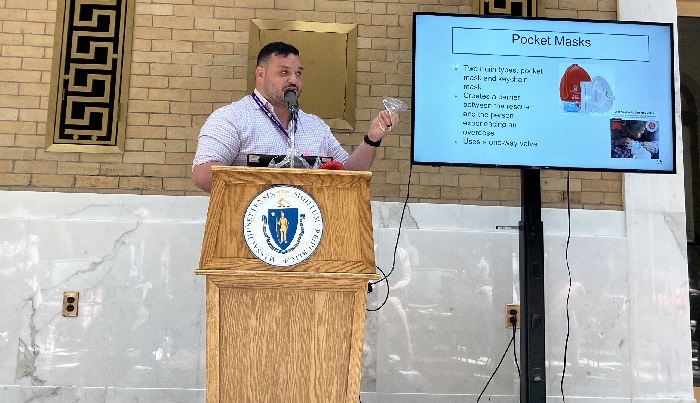latest
Massachusetts “grieving workforce” member shares life-saving techniques

By Alison Kuznitz
STATE HOUSE, BOSTON, JUNE 29, 2023…..Galvanized by the record loss of Massachusetts residents to opioid-related overdoses last year, dozens of lawmakers, legislative staffers and advocates gathered Thursday to learn about how to administer naloxone, a life-saving medication that reverses overdoses.
Massachusetts has distributed 50,000 doses of naloxone to nearly 10,000 people since January — an effort that’s prevented at least 700 overdose deaths, Lt. Gov. Kim Driscoll said.
Combatting the opioid crisis cannot be done in a vacuum, Driscoll said, as she called on “Team Massachusetts” to work together.
“We know that lives are at stake every single day,” she said.
People who do not have medical training can use naloxone that’s injectable or comes as a nasal spray, according to the Centers for Disease Control and Prevention. Having naloxone on hand as a safeguard is the same concept of carrying an EpiPen around in case of allergic reactions, the CDC said.
But that intervention must be paired with pending legislation to create overdose prevention sites, also known as safe consumption sites and safe injection sites, said Stephen Murray, harm reduction program manager at Boston Medical Center, who reviewed how to check people’s breathing and pulse before deciding whether it’s necessary to administer naloxone through a nasal spray. Those sites are an “essential piece of the puzzle,” Murray said, as he noted the impact he’s seen by operating a virtual supervised consumption sites for three years.
“I’m sick of burying my friends; it’s getting old. I lose people constantly,” Murray, an overdose survivor who’s been in recovery nearly 12 years, told the News Service after his presentation. “The people who work in harm reduction, we’re a grieving workforce…This is a life-or-death issue. We can’t continue to delay on this — I would love to see it move forward. I want it to come to a vote.”
Proposals from Reps. Dylan Fernandes and Marjorie Decker and Sen. Julian Cyr (H 1981 / S 1242) would establish a 10-year pilot program for municipalities to pursue local approval to create overdose prevention facilities. Gov. Maura Healey and Health and Human Services Secretary Kate Walsh, who attended the training and advocated for expanded distribution of naloxone, support the facilities, although Healey has not offered her own proposal.
The bills are awaiting a hearing before the Joint Committee on Mental Health, Substance Use and Recovery.
“We’ve been at this for a lot of years, and that’s the big barrier,” Murray told the News Service. “I’m ready to draw a line in the sand and say, ‘Are you with us or not on this issue?'”
Murray said he also wants to see drug checking — which he described as “really important tool” to identify ingredients in drugs — fully legalized.
Decker, the House chair of the Joint Committee on Public Health, stressed the importance of boosting access to naloxone with a broader strategy to combat the state’s worsening crisis and make drug use safer.
“I’m so grateful that many of you are here today, that you want to figure out how to have access to it and also to be properly trained to do this,” Decker, a Cambridge Democrat, said at the event. “We cannot leave anything off the table — every tool that we know that we have that can give somebody one more day to live is a tool that we need to all have access to, which is why my committee, my colleagues and myself continue to be committed to overdose prevention sites.”
Thursday’s event comes a week after state officials released data that showed confirmed and estimated fatal opioid-related overdoses last year hit a record-high of 2,357.
Overdose deaths increased by 42 percent for non-Hispanic Black residents, and the most rural swaths of the commonwealth notched the highest overdose death rate, according to a report from the Department of Public Health.
At the event, Sen. John Keenan recalled a ride-along with Boston Emergency Medical Services, which included a call to a woman who was laying on her front porch and not breathing due to an overdose. People hovered around her not knowing what to do, but Keenan said the emergency responders quickly administered Narcan, the brand name for naloxone.
“To see a person who’s quite, in my perspective, quite visibly dead all of a sudden, in a few moments, sit upright and then with assistance stand up, and then they talk, it’s truly incredible,” Keenan, a Quincy Democrat, said at the event. “Having it (naloxone) as readily available as possible is something that we should absolutely guarantee.”
Yet naloxone is only effective when another individual is present to “push the plunger” on the nose spray for someone who’s overdosed, Murray said during his presentation. The top risk for overdose is being alone, he said.
Murray demonstrated how people can use pocket masks, which provides a one-way airflow to individuals who’ve overdosed, to deliver “rescue breaths.” Naloxone is not sufficient to address someone’s low oxygen levels, Murray said.
Before using naloxone, people should try to wake up potentially at-risk individuals by shouting and shaking them, among other techniques, to determine if the drug is needed, Murray said. People who are hyperventilating aren’t experiencing an overdose, he said.
“Overdosing is very peaceful. You just use and you go out,” Murray said. “You don’t have this sense of impending doom.”
People should be treated with kindness when they wake up after receiving naloxone, as they may immediately feel shame and guilt, Murray said. Drugs are used for multiple reasons, such as to cope with emotional trauma, be social, and to “feel good,” Murray said, urging attendees to see beyond the common portrayal of drug use and addiction intersecting with homelessness.
Murray said his own drug use went undetected for years, even by his family.
“There are probably people in this room who use drugs, and that’s OK,” he said. “I love you, we love you, we’re here for you. And you may be at risk for overdose without knowing it.”





Fed Up
June 30, 2023 at 9:22 pm
Just what the state needs to enable more addicts. They already do with methadone clinics now safe sites. Pretty soon this state with be as bad as Seattle and San Francisco